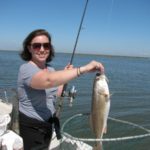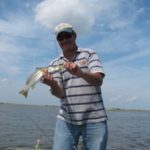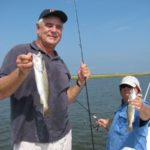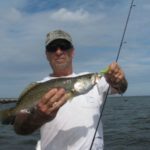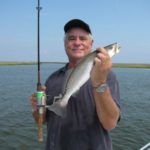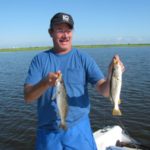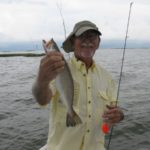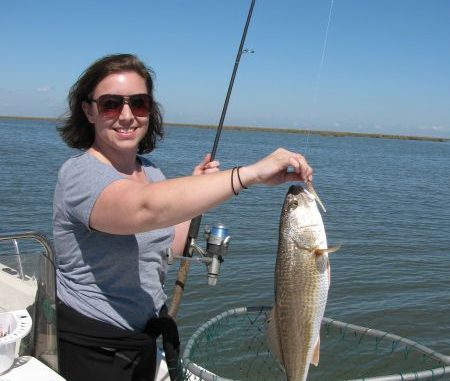
There are certainly hefty trout swimming along the edge of the Gulf of Mexico. But what you’re looking for is crazy action and great table fare, you don’t have to burn much gas out of Cocodrie.
Pelayo punched his iPhone, put it to his ear, and discovered that his cousin Becky and her husband Al planned a trip down from New Jersey for Memorial day weekend. They hadn’t been down since the Saints’ Super Bowl, and Pelayo seemed pleased.
“Great!” he replied. “We’ll make a side trip to Doc’s Cocodrie camp for some fast and furious school speck action. Y’all remember that from a few years ago. This time of year it’s a slam-dunk — a no-brainer — in the upper Lake Pelto Area. We’ll have another short boat haul, get into some school specks under the birds for some action-packed fishing — then enjoy some great eating!”
“What? “Pelayo suddenly frowned. “But come on!” he laughed into his iPhone. “How many times can you walk around da French Kwaaa-taw? Don’t worry, we’ll do the Kwaaa-taw scene for a day, then head down to Doc’s camp for some fishing and feasting. Heck, we’ll feast 10 times better at Da Camp than in any place in da Kwaaaw-ta! And for half the bucks!”
Then Pelayo’s face changed again. “What?!” he yelled into the phone again. “That’s all a buncha greenie baloney! The fish down here are fine, perfectly safe to eat and as abundant as ever. You’ll see.”
The BP oil spill came two months after Becky and Al’s last visit, you see. They’d heard and read much about it, mostly in the national media. They’d been to Doc’s drive-up Cocodrie camp on that visit, and were aghast to see the very Timbalier Bay area featured in many of the news reports on the horrors and devastations of the spill.
So who can blame them for their jitters?
It took some doing on Pelayo’s part — including e-mailing them several Louisiana Sportsman articles by fisheries biologist Jerald Horst — to finally calm their fears and set the fishing trip in motion.
Timing was perfect, too. For specks, as always, water clarity has much to do with successful fishing trips. And a week of light, southerly breezes preceded the arrival of our northern guests, making for clear, greenish water with high salinities. We were all pumped for some fast and furious trout action. And it doesn’t get much faster or more furious (or much easier) than below Cocodrie this time of year.
A short haul to the mouth of the Houma Navigation Canal or Bayou Petite Caillou, then drifting around the islands watching your cork plunge, then the brutal (for such a small fish) lunge, then that gill-rattling frenzy.
For many South Louisianans, May isn’t May without such outdoor action. Speck fishing in winter is often a completely different thing. But this is a far cry from winter-speck fishing, where you tight-line plastic lures to deep holes, then feel that feeble bump, then crank up that feeble-fighting winter-drowsy fish.
The fish we target in this area might not be much bigger than those caught in Oak River or The Wall in fall and winter — but the sheer action of cork fishing under birds shames the other versions of the sport, at least for us.
We used to make the long haul out to the Timbalier beaches, Last Island, Whiskey Pass — all those places — and chunk out live bait for big trout. But you may have noticed that gas isn’t getting any cheaper. Plus, if we want fish that fight, heck, we’ll stalk reds along the shorelines and points just inshore from Bay St. Elaine, or we’ll head to the shallow rigs for mangroves and Spanish. Now THOSE fish fight!
The thrill of trout, it always seemed to us, was the action factor, the absolute BLAST of getting into a school of them in summer and casting at them with tandem rigs. Casting out! Watching the cork plunge! That brutal strike of theirs. Then he erupts on the surface. That yellow mouth thrashing. A little tail walking. Chums on either side of you whoopin’ and doing the same. You heave the trout aboard, shake him loose and cast out again. The cork hits, bounces once — WHAM! The whole thing again. These smaller fish are the best eating, too — by far.
Can’t beat it. And when all is said and done, the consensus from all my lifelong fishing chums is that the area below Cocodrie, above and including Lake Pelto, is about tops for this type of summertime school trout action. We’ve proven it to ourselves time and again.
Tidal range hocus-pocus is also less important in this area, at least in our experience. Certainly moving water is always best. But a low tidal range isn’t usually a deal breaker for school specks in this area. If you find moderately clear water, some current, a little bait action on the surface — not necessarily birds (though that’s unbeatable), just some pogies, mullet flashing around, or some shrimp hopping along, especially near some current lines 100 yards or so off some point or island — find this and you’ve usually found some school specks.
The evening’s festivities featuring much reminiscing with a Margaritaville sound score were still making their presence felt as we started drifting through a current line speckled with little splashes about 100 yards from an island in Bay St. Elaine.
Becky had four trout aboard before Pelayo had his first. Not much hocus-pocus involved with her rig either: tandem chartreuse beetles 2 feet under a popping cork.
“Yeah!” Al groaned from behind me, and I turned around to see his pole bow deeply.
Our very first stop and the action was heating up nicely.
As always, our favorite fishing area is the island-specked juncture of northern Lake Pelto and Terrebonne Bay. Me, I still like my tandem shad rig — the little ones in yellow and white. They caught trout for me in 1968, and they still catch them today. So there.
I rigged my shad rigs about 3 feet under a popping cork and cast toward a little swirl. The cork never stopped. It hit the water and kept going down. For a second I thought it might have gotten tangled, as often happens with tandem rigs. Then I felt the jerk.
“Yowza!” and I lifted the rod and set the hooks. The drag was loose and singing crazily as I cranked away.
Finally, he went airborne. A complete flip, like a chicken dolphin.
“Saw that?’ I howled and looked around.
No one had. They were too busy fighting their own fish. Pelayo’s was thrashing the surface now, rattling that yellow mouth like castanets, sending up a gorgeous froth of water.
“We were ON ’EM!” he howled, as his cousin Becky set the hook and shrieked in delight.
“Yeah, you rite!” Al howled from the bow. “Gotta be a double here!”
And he looked over with a lunatic grin as both his fish went berserk on the surface, one finally jumping off the hook.
Becky was in hysterics.
“You’d have thought you guys had never fished before!” she laughed. “My goodness!”
She had a point. A school speck frenzy still does that to us. It did it on the Metairie lakeshore in 1969, and it does it below Cocodrie today.
I chunked out my shrimp-tipped tandem shad rigs under a cork toward a little swirl, and the cork never stopped. It hit the water and kept going down. Again I thought it might have gotten tangled — then I felt the lunge.
“Whoa!” I reared back, and felt another lunge that almost jerked the rod from my sweaty grip. The drag was loose and singing crazily when a trout went airborne and another thrashed the surface with that gaping yellow mouth.
“Another double right chere!” And it was, but the speck dropped off as I swung them aboard, leaving only the white trout, which was fine with me: They’re every bit as delectable as a school speck, with (amazingly) a lower incidence of those unsightly spaghetti worms.
“Great!” squealed Becky “We’ll fry ’em up tonight!”
“And whole,” added Pelayo as he cast. “The skin garlicky, lemony and crispy, the meat underneath moist and flavorful. Yeah, you right!”
“I’ll make the homemade tartar sauce!” I roared while casting out again (without shrimp-tipping this time.) They were turned on seriously. So no need for “sweetening.”
“Man, I still love catching school trout like this,” Pelayo whooped as he swung aboard a pair (another speck and white duo) on his tandem white beetles. “Like we used to do wading in front of the Lake Villa pumping station when Honky Tonk Woman was No. 1 on the WTIX charts. Only we were using go-go worms and smoky shrimp tails at the time.”
“And side-winders,” I added. “And Mr. Champs.” I smirked as my cork plunged again. “I, for one, am using the same thing I used back then — shad-rigs!”
Then my trout cartwheeled across the surface.
“Can’t beat this, huh, Al?” I yelled, and he whooped a response as a trout smacked his very cork.
Soon Al was savoring those lunges and that surface thrashing on his light spinning tackle. He was using chartreuse Sting Ray grubs under a cork.
As usual under these conditions, at this time of year and in this upper Terrebonne area, lure color and style was irrelevant. The school specks smacked everything we threw at them — though it seemed they smacked the shrimp-tipped ones with a bit more gusto and hung on a bit longer.
A few minutes later I was unhooking Becky’s tenth trout —about a 15-incher, big by our standards. Then her rat-red (17 incher, a keepah!) that somehow beat the school specks to her beetle.
We never get into truly monster trout by fishing this area and this way. But who cares? We want fast action and a fish fry.
We ended up with 18 from this school, after maybe five throwbacks, and then set out to find another — which took all of 10 minutes by heading along the northern coast of what old maps term Bay St. Elaine.
We’d motored barely half a mile south when Pelayo pointed.
“That’s them!” he bellowed.
Sure enough, some gulls (the black-headed ones) were hovering, with another dozen or so sitting on the water resembling a small flock of malnourished dos gris. They were maybe a hundred yards off a grassy point.
Seven times out of 10, beneath these gulls you’ll find feeding school specks, pushing up shrimp for them. On the other hand, if you cast around diving terns, the ones that make that creaky, squeaky sound and smack into the water head first after diving like a Stuka, you usually catch sail cats or ladyfish.
Farther out or along the coast, however, terns often signal feeding Spanish mackerel, and we eagerly pounce on these.
Half of these gulls were sitting on the water. A few others were hovering and dipping their beaks. A current line formed right past them. Little swirls and various forms of surface commotion rippled the surface. Everything looked perfect.
Pelayo killed the motor about a hundred yards away, and we drifted in just as the gulls started lifting. In seconds the action was as hot as at the first stop. We laughed as boats headed past us all morning — all heading south, all spending outrageously expensive gallons of gas.
And perhaps they caught trout larger than ours: But we sure weren’t complaining.
We found them under the gulls in the open water. We found them around current lines off points. We fished like we fished along the (then wild and undeveloped) Metairie/Kenner lake front as grammar-school hoodlums. No hocus-pocus or dilettantism for this type of fishing — and we had a blast.
Had we somehow struck out in this area, we would have kept heading south. Generally speaking, the closer to the Gulf, the bigger the specks.
Years ago ace fishing guide Tommy Pellegrin concisely explained the process for finding the bigger trout along the beaches.
“Don’t get hung up on fishing deep water, Hom-Boy-Da,” he counseled. “I’ve found that these trout like to hang in fairly shallow water, closer to shore, usually right where the waves are breaking.
“I especially look for sandbars or shoals that lie perpendicular to the shore. There’s always a few of these. You find them by watching where part of a wave breaks before the rest of it. These are always the hotspots.
“On an outgoing tide, I look for gaps perpendicular to the shore, connecting the main troughs that run parallel to the shore. Trout swarm in these as the tide’s dropping. These are their thoroughfares for getting back out to the deeper water. Again, you find these by watching the waves. These gaps are located in those sections of the shore where you notice that waves don’t break.”
We didn’t come close to four-man limits, keeping another 46 schoolies, with maybe 10 throwbacks. But we had a blast.
Most were filleted back at Doc’s camp, but a dozen remained whole for the evening feast, which — along with the oysters and boudin brought over by Doc’s country cousins — was divine!
